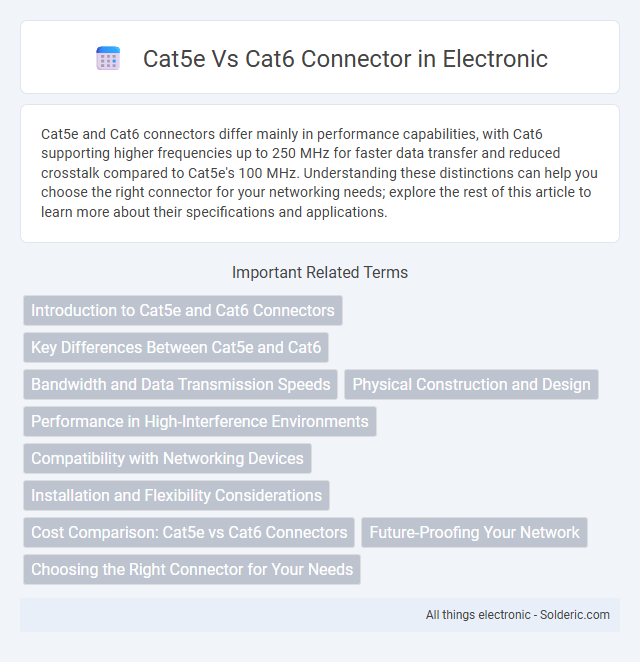Cat5e and Cat6 connectors differ mainly in performance capabilities, with Cat6 supporting higher frequencies up to 250 MHz for faster data transfer and reduced crosstalk compared to Cat5e's 100 MHz. Understanding these distinctions can help you choose the right connector for your networking needs; explore the rest of this article to learn more about their specifications and applications.
Comparison Table
| Feature | Cat5e Connector | Cat6 Connector |
|---|---|---|
| Maximum Data Speed | 1 Gbps | 10 Gbps |
| Frequency | 100 MHz | 250 MHz |
| Connector Type | RJ45 | RJ45 |
| Shielding | Unshielded or Shielded | Typically Shielded |
| Compatibility | Compatible with Cat5 and Cat5e cables | Compatible with Cat6 cables |
| Use Case | Standard office networks, basic internet | High-speed networks, data centers, gaming |
| Distance for Max Speed | Up to 100 meters | Up to 55 meters at 10 Gbps |
Introduction to Cat5e and Cat6 Connectors
Cat5e and Cat6 connectors are designed to terminate twisted pair cables used in Ethernet networking, each supporting different performance standards. Cat5e connectors handle up to 1 Gbps speeds with a maximum frequency of 100 MHz, suitable for most home and office networks. Cat6 connectors support speeds up to 10 Gbps and frequencies up to 250 MHz, offering improved crosstalk reduction and bandwidth for high-performance network environments.
Key Differences Between Cat5e and Cat6
Cat5e connectors support speeds up to 1 Gbps at 100 meters, while Cat6 connectors handle speeds up to 10 Gbps at shorter distances (55 meters). The Cat6 connector features tighter specifications for crosstalk and system noise, improving network performance and reducing interference. Your network's speed and interference tolerance requirements determine the optimal choice between Cat5e and Cat6 connectors.
Bandwidth and Data Transmission Speeds
Cat6 connectors support higher bandwidths up to 250 MHz compared to Cat5e connectors, which typically support up to 100 MHz. This increased bandwidth in Cat6 enables data transmission speeds of up to 10 Gbps over shorter distances (up to 55 meters), whereas Cat5e supports speeds up to 1 Gbps over 100 meters. Enhanced shielding and reduced crosstalk in Cat6 connectors contribute to improved signal quality and faster, more reliable data transmission.
Physical Construction and Design
Cat5e connectors feature a simpler design with thinner insulated wires and smaller, less precise internal contacts, supporting up to 1 Gbps speeds over shorter distances. Cat6 connectors incorporate thicker, more rigid insulated wires and enhanced shielding within the connector to reduce crosstalk and electromagnetic interference, enabling support for 10 Gbps speeds at distances up to 55 meters. The physical construction of Cat6 connectors includes tighter twists and separator elements that maintain cable integrity and signal quality compared to Cat5e designs.
Performance in High-Interference Environments
Cat6 connectors offer superior performance in high-interference environments due to their enhanced shielding and tighter twists in cable pairs, reducing crosstalk and electromagnetic interference more effectively than Cat5e connectors. The improved signal integrity of Cat6 enables stable Gigabit Ethernet and 10 Gigabit Ethernet transmissions over shorter distances, essential for data centers and industrial settings. Cat5e connectors, while reliable for standard networking, may experience increased signal degradation and lower throughput in environments with significant electrical noise.
Compatibility with Networking Devices
Cat5e and Cat6 connectors are both compatible with a wide range of networking devices, including routers, switches, and network interface cards (NICs). While Cat6 connectors support higher data transmission rates and reduced crosstalk, they are backward compatible with Cat5e cables and devices, allowing seamless integration. Your choice of connector should consider device specifications and network performance requirements to ensure optimal compatibility.
Installation and Flexibility Considerations
Cat5e connectors offer easier installation with greater flexibility in tight spaces due to their smaller size and simpler termination process, making them ideal for home or light commercial setups. Cat6 connectors require more precise termination and are less forgiving during installation but deliver superior performance for high-speed networks, ensuring future-proofing in demanding environments. Your choice depends on balancing installation ease with the need for enhanced data transmission capabilities.
Cost Comparison: Cat5e vs Cat6 Connectors
Cat5e connectors are generally more cost-effective than Cat6 connectors, with prices typically ranging from $0.30 to $0.60 per connector compared to Cat6's $0.50 to $1.00 per connector. The higher cost of Cat6 connectors is attributed to their enhanced design, which supports higher bandwidth and reduced crosstalk. Choosing Cat5e connectors can reduce overall installation expenses without compromising performance for most standard networking needs.
Future-Proofing Your Network
Cat6 connectors offer superior performance with reduced crosstalk and higher bandwidth capabilities up to 10 Gbps over 55 meters, making them more suitable for future-proofing your network compared to Cat5e. While Cat5e connectors support speeds up to 1 Gbps and frequencies up to 100 MHz, Cat6 supports up to 250 MHz, accommodating increasing data demands and advanced applications. Investing in Cat6 connectors ensures greater longevity and compatibility with emerging technologies, minimizing the need for frequent network upgrades.
Choosing the Right Connector for Your Needs
Choosing between Cat5e and Cat6 connectors hinges on network speed and interference requirements; Cat5e connectors support speeds up to 1 Gbps and are sufficient for most home networks, while Cat6 connectors handle up to 10 Gbps with better crosstalk and noise reduction, ideal for more demanding environments. Both connectors utilize RJ45 jacks but Cat6 connectors often include enhanced shielding features that improve performance over longer distances. Selecting the correct connector ensures optimal data transmission quality and future-proofs your network infrastructure.
Cat5e vs Cat6 connector Infographic

 solderic.com
solderic.com